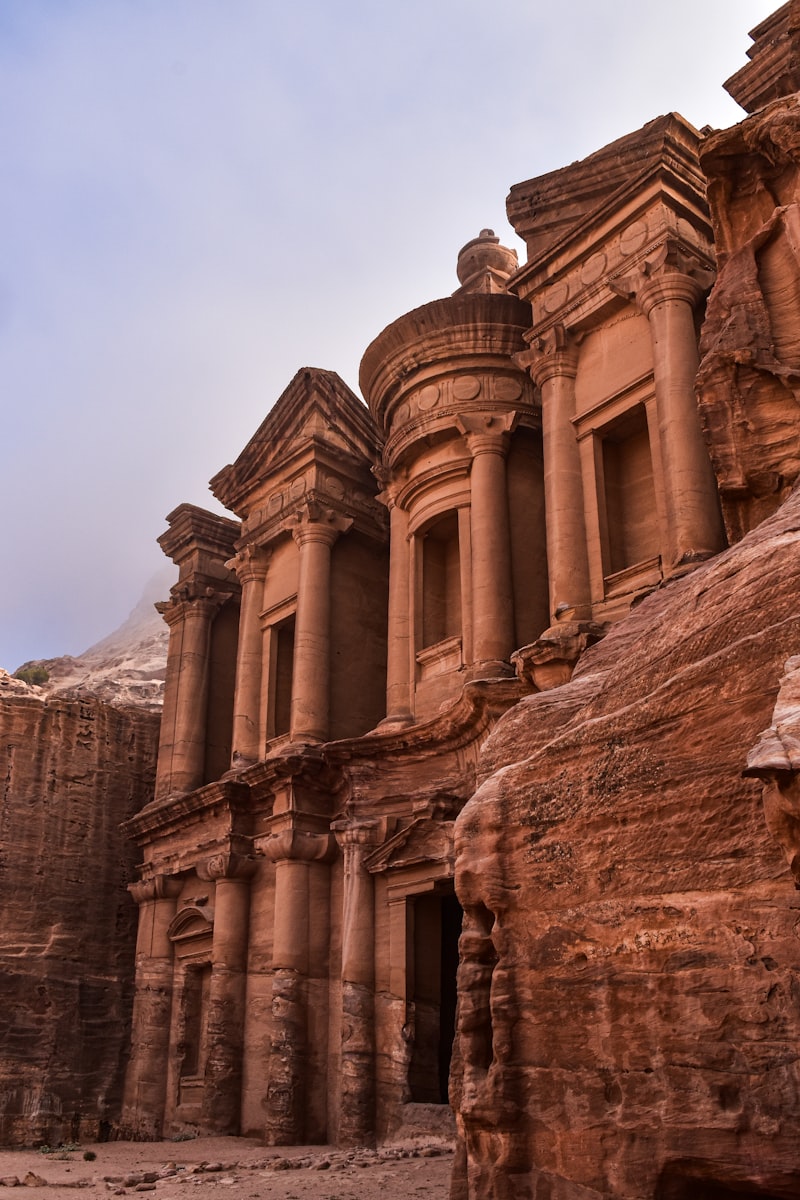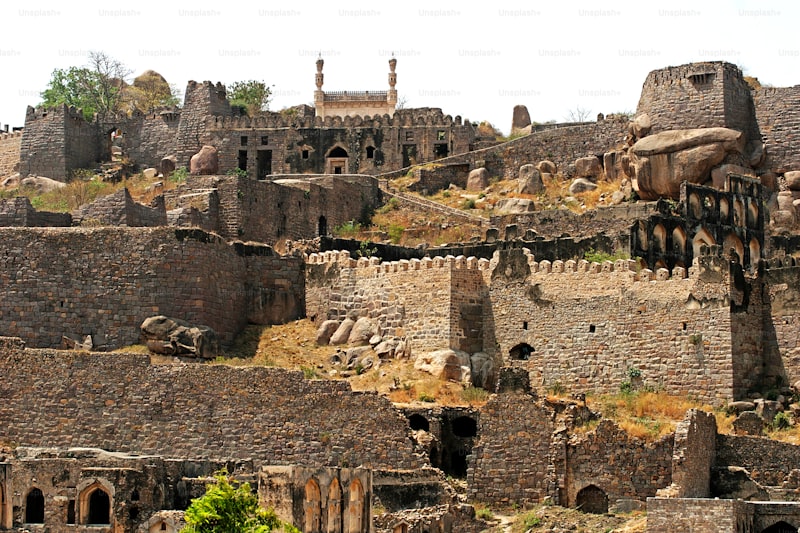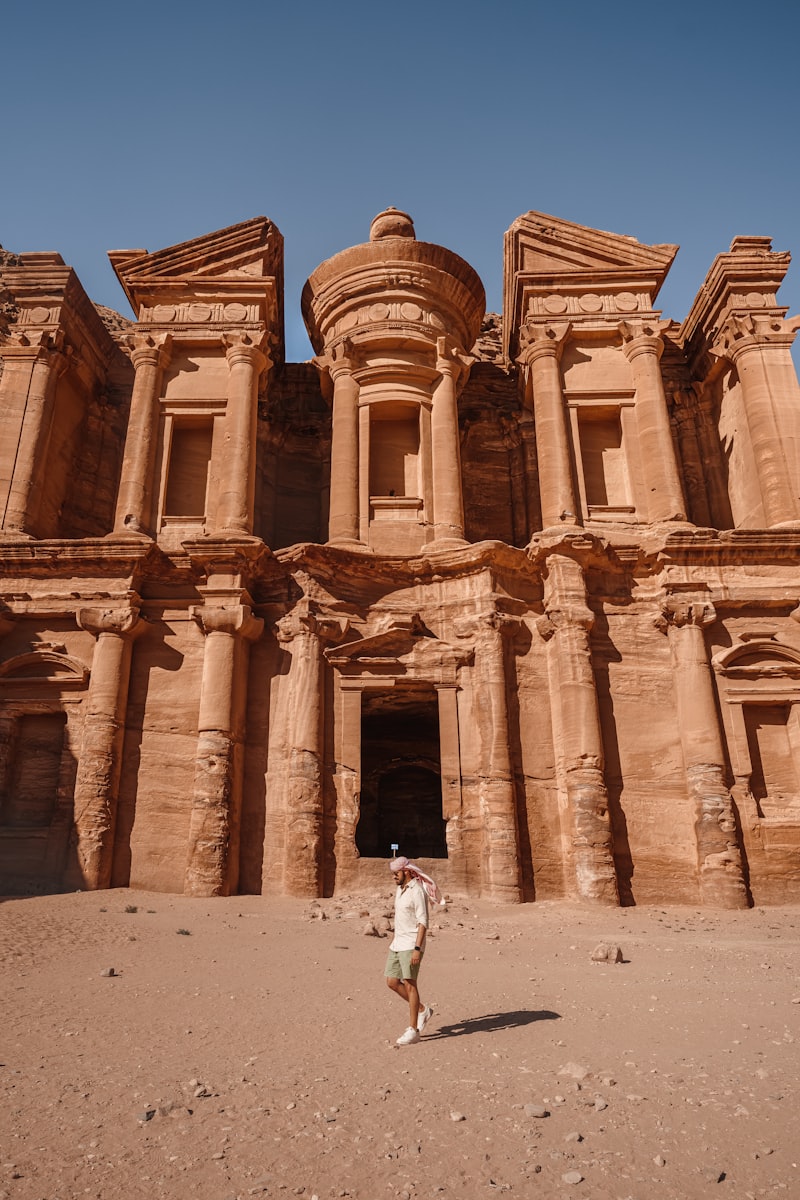Have you ever wondered what secrets lie within the ancient city of Petra? Nestled amidst the rugged desert canyons of Jordan, Petra stands as a testament to the ingenuity and craftsmanship of ancient civilizations. Known as the “Rose City” due to the color of its stone, Petra is a UNESCO World Heritage site that continues to awe visitors from around the globe.
Imagine walking through a narrow gorge, surrounded by towering cliffs that seem to touch the sky. This is the Siq, the main entrance to Petra, which winds its way for over a kilometer before revealing the iconic Treasury, carved directly into the sandstone rock face. As you emerge from the Siq and catch your first glimpse of this architectural marvel, you can’t help but be amazed at the intricate details and sheer size of the Treasury.

But Petra isn’t just about the Treasury. Beyond this iconic facade lies a vast city that was once a thriving hub of trade and culture. Wander through the ancient streets lined with tombs, temples, and houses carved into the cliffs. Each structure tells a story of the Nabataeans, the industrious people who built and inhabited Petra over two millennia ago.

One of the most impressive features of Petra is its sophisticated water management system. Despite being located in a desert region, the Nabataeans were able to channel and store water using dams, cisterns, and channels carved into the rock. This engineering marvel allowed Petra to flourish as a major trading center along the Silk Road.
As you explore Petra, you can’t help but marvel at the blend of natural beauty and human craftsmanship. The vivid hues of the sandstone cliffs, ranging from pink to red to orange, create a stunning backdrop against the clear blue sky. It’s no wonder Petra has captivated travelers, historians, and archaeologists for centuries.
Ready to uncover the mysteries of Petra? Plan your journey to this extraordinary archaeological site and immerse yourself in the wonders of an ancient civilization carved in stone.
Unveiling Petra: A Journey Through Jordan’s Ancient Jewel
Have you ever imagined stepping into a realm where history whispers through magnificent stone-carved structures? Petra, nestled in the rugged desert canyons of Jordan, is not just a destination; it’s a time machine that transports you back to ancient times. This UNESCO World Heritage site, famously known as the “Rose City” due to the hues of its stone, is a marvel of human ingenuity and natural beauty.
Imagine walking through a narrow gorge flanked by towering cliffs, only to emerge at the iconic Treasury (Al-Khazneh), with its intricate façade carved into the rosy sandstone. It’s a moment that captures the imagination and leaves you in awe of the Nabateans, who sculpted these architectural wonders over two millennia ago.
Petra isn’t just about the Treasury, though—it’s a vast archaeological site covering over 100 square miles. Each turn reveals new wonders: the grandeur of the Monastery (Ad Deir), perched high on a mountain with sweeping views; the ancient Roman Theater, where performances once echoed against stone; and countless tombs and temples that speak of a thriving ancient civilization.
But Petra’s allure isn’t solely historical. It’s also a place where nature paints its canvas with vibrant colors—the contrast of red rocks against clear blue skies is a photographer’s dream. The Siq, the main entrance to Petra, offers a dramatic introduction as you wind your way through its towering cliffs, marveling at the play of light and shadow.
Visiting Petra isn’t just a journey through Jordan’s past; it’s an experience that resonates with anyone who appreciates history, architecture, and the sheer wonder of exploration. Whether you’re tracing the footsteps of Indiana Jones or simply soaking in the atmosphere of this ancient wonder, Petra promises to leave an indelible mark on your soul.
Secrets of Petra: Unraveling the Mysteries of an Ancient City
Imagine stepping through the narrow Siq, a gorge that winds its way through towering rock formations, revealing the Treasury’s iconic facade at its end. The sheer grandeur of this moment transports you back in time, as if you’ve stumbled upon a lost realm. How did the Nabataeans achieve such architectural mastery in this rugged terrain? The intricacy of their water management system, channeling scarce desert springs to sustain life within Petra’s walls, remains a testament to their engineering ingenuity.
But Petra’s allure extends beyond its impressive facades and hydraulic feats. Its rock-cut tombs, like the intricately adorned Urn Tomb and the majestic Royal Tombs, whisper tales of ancient rites and royal burials. Each carving, each detail etched into the sandstone, speaks volumes about the Nabataean culture and their reverence for the afterlife.
As you explore deeper into Petra, beyond the well-trodden paths, you discover lesser-known wonders like the High Place of Sacrifice, where ceremonies once honored deities with panoramic views over the city. How did these rituals shape Nabataean society, blending influences from ancient Arabia, Egypt, and the Mediterranean?
Petra’s mysteries continue to unfold with ongoing archaeological excavations and research. Every new discovery, whether a fragment of pottery or a hidden inscription, adds another layer to the narrative of this enigmatic city. What more lies buried beneath its sands, waiting to be unearthed?
For adventurers and historians alike, Petra remains a place of wonder and intrigue—a testament to human creativity and perseverance in the face of harsh desert landscapes. As you stand before the Monastery, Petra’s largest monument, carved high into the cliffs, you can’t help but wonder: what other secrets does this ancient city hold, waiting for the next curious soul to unravel?
Timeless Beauty: Exploring the Architectural Marvels of Petra
Petra’s history dates back to around 300 BC when it flourished as the capital of the Nabataean Kingdom. Its strategic location along major trade routes enabled Petra to prosper through trade in frankincense, myrrh, and spices, accumulating wealth that manifested in its grand architectural achievements. The city’s unique architecture is a blend of Nabataean and Greco-Roman influences, carved directly into the rock faces of the surrounding mountains.
One of the most iconic structures in Petra is Al-Khazneh, or the Treasury, carved with intricate details into a towering sandstone cliff. This elaborate mausoleum served as a royal tomb and is renowned for its breathtaking façade, which has been featured in numerous films and captivates visitors with its beauty and mystery.
Visitors to Petra enter through the Siq, a narrow gorge flanked by soaring cliffs that dramatically opens up to reveal the Treasury. This natural geological formation not only served as a ceremonial entrance to the city but also showcases the Nabataeans’ architectural prowess in manipulating natural landscapes.
Beyond its architectural splendor, Petra holds immense cultural significance as a crossroads of civilizations, reflecting influences from ancient Mesopotamia, Egypt, Greece, and Rome. Excavations and ongoing research continue to uncover new insights into Petra’s past, making it a dynamic site for archaeological study and historical exploration.
Today, Petra attracts tourists and history enthusiasts from around the globe who marvel at its timeless beauty and historical significance. Guided tours offer insights into the city’s history, architecture, and cultural context, while visitors can explore numerous tombs, temples, and dwellings carved into the rock.
Petra’s architectural marvels and rich history make it a testament to human creativity and ingenuity. Its blend of natural beauty and ancient craftsmanship continues to inspire awe and wonder, ensuring that Petra remains a cherished destination for generations to come.
From Rock to Rose Red: The Unique Geology of Petra
Imagine this: millennia ago, when the Earth was still shaping itself, vast layers of sandstone were gradually deposited in this region. Over time, these layers compressed and solidified, forming the vibrant red sandstone that defines Petra today. It’s as if nature itself meticulously painted each cliff and canyon with a brush dipped in hues of crimson and ochre, creating a breathtaking canvas unlike any other.
But Petra’s geological wonders don’t stop there. The city is famously known for its rock-cut architecture, where entire structures were carved directly into the towering sandstone cliffs. Walking through the narrow Siq, a natural gorge that serves as the main entrance to Petra, one can’t help but marvel at the sheer ingenuity of the Nabataean craftsmen who transformed these natural rock formations into elaborate temples, tombs, and dwellings.
One of the most iconic structures within Petra is Al-Khazneh, or the Treasury, with its intricately carved facade that glows golden in the sunlight. It’s almost as if this monumental tomb emerges magically from the heart of the rock itself, a testament to both human artistry and the geological marvels that provided the canvas.

Petra’s geological uniqueness isn’t just about its striking appearance. The sandstone cliffs also bear witness to the passage of time, etched with layers that reveal a geological history spanning millions of years. Each crevice and fissure tells a tale of ancient seas, shifting continents, and the slow but steady process of erosion that continues to shape this landscape today.
Visiting Petra is like stepping into a time machine where history, art, and geology converge in a symphony of colors and textures. It’s a place where the Earth’s past is palpable, where every grain of sandstone whispers secrets of epochs long gone. Whether you’re a history enthusiast, a geology buff, or simply a traveler in search of awe-inspiring beauty, Petra promises an experience that transcends time and leaves an indelible mark on the soul.
Frequently Asked Questions
Why is the Treasury in Petra famous?
Discover why the Treasury in Petra is renowned for its intricate rock-cut architecture and historical significance, attracting visitors worldwide.
How can visitors explore Petra safely and respectfully?
Discover Petra safely and respectfully by staying on marked paths, respecting local customs, and avoiding climbing or touching ancient structures. Stay hydrated, wear sun protection, and carry essentials like a map and water. Engage with licensed guides for insights and follow designated visiting hours to preserve this UNESCO World Heritage site.
What are the main attractions to visit in Petra?
Discover the main attractions of Petra with our concise guide. Learn about iconic landmarks like the Treasury, the Monastery, and the Siq, offering rich historical and architectural marvels in this ancient Nabatean city.
How was Petra built and by whom?
Discover the ancient city of Petra, marvel of ancient engineering and architecture, believed to have been built by the Nabataeans, an Arab people who thrived in the region around 300 BCE. Explore its breathtaking rock-cut structures and intricate water management systems that made Petra a thriving trade hub in its time.
What is Petra and why is it considered a historical wonder?
Discover Petra, a renowned archaeological site in Jordan famed for its ancient rock-cut architecture and water conduit system. As one of the Seven Wonders of the World, Petra captivates with its blend of natural beauty and cultural significance, reflecting the Nabataean civilization’s engineering prowess and historical legacy.



